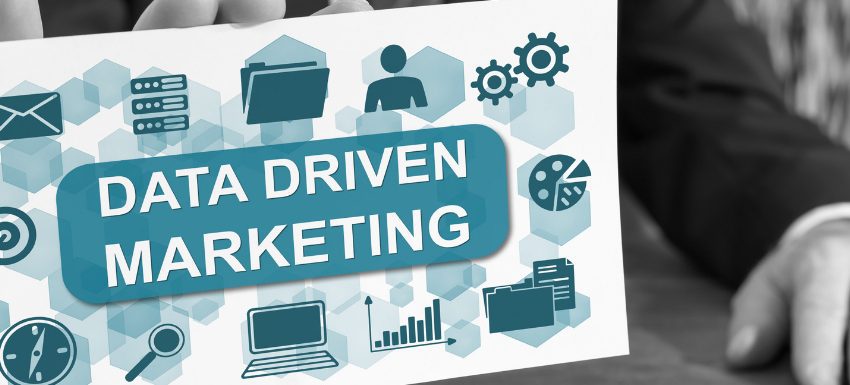Do you want to implement data-driven marketing for your organization or client? Find out how to create a data-driven strategy for marketing step-by-step.
Every marketer aims to reach their target audience and deliver a compelling message that will invite prospects to buy the product or service. But, most fail to do so as strategies are not related to the customer data.
To become a successful marketer, a minute understanding of customers and emotions is not enough. You need data-driven feedback to get better results from your marketing strategies. That’s why we have chosen to tell you about data-driven marketing strategy.
Read on to learn the importance of data in marketing and how you can create a data-driven strategy using a stepwise guide.
Importance of Data in Marketing
In the early days of marketing, mass-level targeting was done through direct mail, posters, and advertisement in mass media like newspapers, radio, and television. Later, companies started to focus on direct marketing using direct mail and telemarketing.
If you compare today’s scenario with the yesteryears, you will notice a drastic change in the marketing strategies. Mails are rarely used, and competition has grown manifold. Now, marketers depend on market data and customer information collected during the buying process.
In fact, your marketing strategies need to be data-driven to be successful. When you have a clear understanding of the behavior, goals, pain points, and challenges of your target audience, you can easily create marketing campaigns suitable for their specific needs.
Other metrics that help you with your marketing efforts are browsing patterns, online purchase behavior, and social media activity. So you can see that data is at the core of any successful marketing strategy, and you simply cannot ignore it if you want to create effective campaigns.
What Is Data-Driven Marketing?

Data-driven marketing is the combination of techniques to utilize a large volume of customer data to create a marketing plan. The data helps marketers to understand customer behaviors, preferences, and purchase motives in a better way and develop effective marketing strategies.
This is useful for all industries and businesses as it improves customer experience, resulting in greater revenue. Using the data, marketing professionals can better predict their objectives and future actions and create personalized marketing strategies for each segment of their client base.
Marketing data analysis makes businesses aware of customer requirements. Moreover, it lets you identify the drawbacks of the existing marketing strategy. Hence, you can track the effectiveness of campaigns over time.
Nowadays, data-driven marketing has become immensely popular due to the dependency on data analytics for decision-making and the high availability of data. In the near future, you can expect to see more businesses joining this marketing effort.
To understand data-driven marketing from its foundational level, you must look at the differences between traditional marketing and data-driven marketing below:
Traditional Marketing
- It uses offline marketing data available from third-party market research agencies.
- This marketing practice relies on offline advertising like flyers, ads on radio stations, and ads on TV.
- Traditional marketing targets a huge population while the entire population may not be looking for the marketed products.
- Advertising through TVs and radios is extremely costly, while the return on investment (ROI) may not be proportional. It’s usually lower than expected returns.
- You can not update a traditional advertising system overnight.
- There are upfront fees and fixed fees to run traditional advertisements on TV channels.
- Experimenting scope with the marketing approach is too narrow or costly.
Data-Driven Marketing
- Relies on updated customer data from various online resources that are not always costly.
- Sometimes, you can set up your own tools and websites to collect real-time customer data.
- You can target niche audiences in different regions for a specific product or service during your marketing campaigns.
- Data-driven marketing uses online advertising on websites, apps, and social media platforms. This mode of advertising is affordable, and most advertising agencies offer pay-as-you-go models.
- You can stop or update your advertising campaigns run under data-driven marketing depending on the performance data of previous hours, days, and weeks.
- Your marketing team can change the advertising content like image, color palettes, theme, text copy, pricing, promotional discount etc., in real-time depending on analytics data received from the advertising agency’s ad-tracking tools.
Now that you know the differences, let us explore an example that shows how data-driven marketing works differently than traditional marketing here:
Understand Data-Driven Marketing by Example
Suppose, you are the manufacturer of various consumer goods. In the traditional marketing approach, your marketing team will buy current market data related to your products. They can also run focus groups of a few customers to understand their needs and desires.
Then, you create marketing collaterals like billboards, newspaper advertisements, TV ads, radio ads, flyers, brochures, and so on for strategic placement. You normally place these where the eyeballs are the most, like nationally aired TV channels for TV ads, subways for billboards, and many more.
You are paying huge marketing and advertising fees to show your products to everyone. But, not all the audience needs your products. Your cost per audience for marketing and advertising is much higher than the number of customers you can convert, and you have no idea how many people are converting via a particular channel unless you specifically ask them. It’s as good as shooting in the dark.
For the same products, you can use data collected from websites, apps, and social media about the audience’s behavior and needs. Then, you can customize the online advertising campaigns to show specific products to the audience who needs them. You can target your audience by their online behavior, demographics, interests, etc. You can track which campaign resulted in more conversions and increase spending on that campaign. Thus, you pay for marketing for the audience that has the potential to convert, not the bystanders.
How to Create Data-Driven Marketing Strategy?
Find below the must-have steps to create a data-driven marketing strategy:
#1. Set an Objective for the Marketing Effort
Your data-driven marketing strategy will depend on the target you want to achieve. For example, you must include the following goals:
- Boost brand awareness in the market
- Increase sales revenue
- Get more visitors and subscribers for your website and mobile app
- Improve customer journey to subscriptions or purchases
- Increase customer satisfaction and website/mobile app ratings
The best approach is to follow the SMART goal-setting strategy. You can learn more on SMART here: SMART Goal Examples.
#2. Collect Data

Now that you have a clear objective or goal for your marketing efforts, it is time to collect high-quality data about the following:
- Your business
- Your products
- Services you offer
- Competitors of the same products and services
- The market where you sell your services and products
- Your existing customers
- The target audience
- Your app and website visitors
- Product page and app visitors who view a product but do not buy
- Visitors who add products or services to the cart but do not checkout
- Users who only buy specific subscriptions or products
These are the data that you can collect using your own tools or from third-party data agencies. You can also run feedback campaigns in different customer bases to collect first-party data. Such data are beneficial since you get honest reviews and suggestions from your target audience.
#3. Organizing the Data
You must cleanse, sort, and organize data so that data analytics tools can read your data and provide insights. This phase includes the following:
- Removing irrelevant data
- Fixing blank data fields
- Deleting anomalies and unwanted characters
- Eliminate duplicate entries
- Fix extra columns and rows
You can automate these tasks by setting up and using these data cleansing strategies and tools.
You may also need the best ETL tools if you want to store data in data warehouses like Snowflake, Google BigQuery, and Amazon S3.
#4. Build a Team to Analyze and Act on Data

You can use a third-party agency to analyze your data, where you just pay for the insights. However, that agency may not understand your business model and marketing strategy well enough as an in-house team would. Thus, setting up an in-house team pays off in the longer run.
#5. Track and Measure Progress
You must constantly track the data-driven marketing campaigns for the metrics you have chosen at the beginning of the project. If you do not see satisfactory results, immediately re-analyze the existing data, and superimpose the data insights on current marketing data to optimize the marketing campaigns.
This will fetch better results. Thus, measuring progress is indispensable in any data-driven marketing scheme.
Benefits of a Data-Driven Marketing Strategy
#1. Create Targeted Marketing Campaigns
With the help of data-driven marketing, you can create highly-targeted campaigns that will deliver personalized and unique messages to each customer. As the data gives you insight into the interests, lifestyle, and online activities of each customer, you can create content that will attract them to your business. It will also help you to know where and when to post marketing content and advertisements.
#2. Keep Your Messages Consistent
To gain success in marketing, your messaging should be consistent and aligned with the customer’s interest. As you use the data collected through various channels, it offers you a better view of the customer’s interests. These diverse insights ensure your messaging remains consistent and aligned.
#3. Know Your Marketing Strategies Better
When your marketing strategies fail for any reason, the customer acquisition cost increases. As a result, it becomes more difficult for a company to achieve ROI. With data-driven marketing, you can easily understand what works for you and what doesn’t. Thus you can determine where to spend your time and budget.
#4. Get Your Audience Segmented
Over time, your customers have also grown up to be smarter. Now, it is not possible to pursue everyone to the same message or the same marketing tactics. This is where data-driven strategies come into play. Data lets you segment your audience based on behavior, habit, purchase history, and demographics. Later you can offer them tailored marketing efforts depending on the buyer’s journey stages.
#5. Understand Your Prospective Customers
Someone does not have to be your customer for you to know about them. With the help of data-driven marketing, you can know your potential customers before interacting with them. As you become familiar with their interests and preferences, targeting them with the perfect messaging for persuasion becomes easy.
#6. Create a Buzz Around Your Brand

A marketing campaign is not all about getting the attention of the target audience. The more people notice you through a marketing campaign, the better it works for your product and brand identity. When your marketing strategies are powered by data, you can create a buzz around your product. Thus, you can attract a large number of people to your products.
#7. Ensure a Better Marketing Experience
By including data in your marketing strategy, you are not only bringing in more sales and revenue but also ensuring a better experience for your audience. As you present them with the kind of messaging they love, you will not end up annoying them. With a happy audience, you can expect to get a smooth conversion.
#8. Get More Cross-Selling and Up-Selling
When you use data-based marketing, you get rare insights that help you quickly move potential customers through the sales funnel and make the process more cost-efficient. It can also present you with cross-selling opportunities throughout the sales funnel.
When a customer purchases a product from your platform, you can utilize the data to keep customers engaged post-sale. This engagement often leads to loyal customers who will make future purchases from your company.
Conclusion
No matter which company or industry you belong to, data-driven marketing strategies are crucial for the success of your campaigns. This type of marketing allows you to leverage the power of data analytics to reach the right audience. These strategies are the only way for you to achieve the expected ROI in this highly competitive world.
Here, we have discussed data-driven marketing strategies and their benefits. Now that you know the steps to create a data-driven marketing strategy, you should not have trouble creating one for your company.
You can also read about content creation tools and important elements of a successful video marketing campaign.
Si quiere puede hacernos una donación por el trabajo que hacemos, lo apreciaremos mucho.
Direcciones de Billetera:
- BTC: 14xsuQRtT3Abek4zgDWZxJXs9VRdwxyPUS
- USDT: TQmV9FyrcpeaZMro3M1yeEHnNjv7xKZDNe
- BNB: 0x2fdb9034507b6d505d351a6f59d877040d0edb0f
- DOGE: D5SZesmFQGYVkE5trYYLF8hNPBgXgYcmrx
También puede seguirnos en nuestras Redes sociales para mantenerse al tanto de los últimos post de la web:
- Telegram
Disclaimer: En Cryptoshitcompra.com no nos hacemos responsables de ninguna inversión de ningún visitante, nosotros simplemente damos información sobre Tokens, juegos NFT y criptomonedas, no recomendamos inversiones

